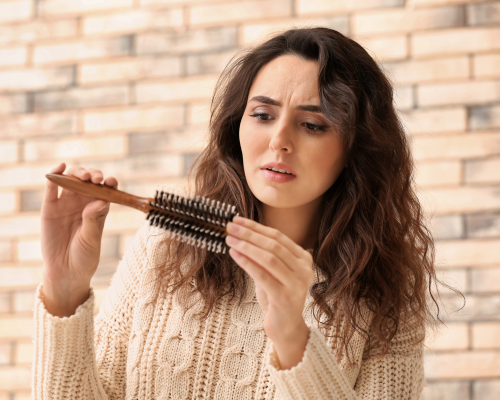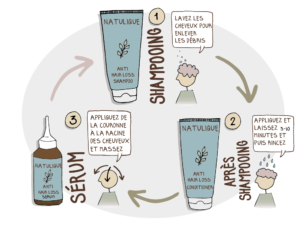Introduction to early-onset alopecia
Definition of premature alopecia
Premature alopecia refers to hair loss that occurs prematurely, often before the age of 30. This condition can affect both men and women, and manifests itself as progressive thinning of hair on the scalp. It is crucial to detect this condition in its early stages to better manage its long-term effects.
Different types of alopecia
Alopecia comes in a variety of forms, each with distinct characteristics:
- Androgenetic alopecia: Commonly referred to as male or female pattern baldness, it is often linked to hormonal and genetic factors.
- Alopecia areata : Sudden bald patches on the scalp.
- Telogen effluvium : Caused by stress, illness or hormonal changes, leading to diffuse hair loss.
Causes of premature alopecia
Genetic factors
One of the main factors contributing to premature alopecia is genetics. If a close family member has suffered from baldness or early hair loss, it's possible to inherit the same predisposition. Genes influence the sensitivity of hair follicles to hormones such as dihydrotestosterone (DHT), which plays a crucial role in follicle miniaturization and hair loss.
Environmental factors
Environmental factors can also accelerate or provoke early alopecia. Exposure to harsh chemicals, intensive use of heated styling appliances, daily stress and lifestyle can all contribute to accelerated hair loss. In addition, a diet deficient in essential nutrients can weaken hair and lead to early loss.
Common signs of premature alopecia
Excessive hair loss
One of the most obvious signs of premature alopecia is excessive hair loss. This phenomenon can manifest itself in a variety of ways, alerting those concerned that medical attention or a change in hair care habits may be required.
Observation of sparse areas
Sparse areas on the scalp are often the first visible indicators of early alopecia. These areas may appear irregularly and vary in size, but they generally indicate that the hair in these areas is becoming thinner and more fragile. This can happen gradually, making hair loss sometimes difficult to detect immediately.
Hair loss on washing or brushing
If you notice an abnormally high amount of hair loss when washing or brushing, it could be a sign of early alopecia. It's normal to lose a few hairs every day, but a sudden increase in the amount of hair in the shower drain or on the hairbrush can be cause for concern. This type of loss is often an early warning sign of alopecia.
Changes in hair quality
In addition to physical hair loss, early alopecia can also manifest itself through changes in the texture and quality of your hair. These transformations may indicate that the hair follicles are beginning to change in a way that precedes hair loss.
Thinner or weaker hair
Hair that becomes progressively thinner or weaker is a common early sign of alopecia. Hair follicles can produce hair of reduced diameter as the hair growth cycle is disrupted. This can make the hair overall less full and more prone to breakage.
Dry, brittle hair
In addition to general thinning, hair can also become dry and brittle. This can be due to a reduction in the natural oils produced by the scalp, which is often a result of hormonal changes or environmental damage. Dry hair tends to break more easily, further contributing to the appearance of hair loss.
Paying attention to these early signs of alopecia is crucial to better understanding and managing the condition. A diagnosis and treatment can help slow the progression of alopecia and maintain healthy hair. If you notice these symptoms, we recommend that you consult a dermatologist or health care professional for a thorough evaluation.
See also: How to choose a shampoo for brittle hair?
Diagnosis of early-onset alopecia
Hair self-examination
Regular hair self-examination can be an essential preventive method for detecting early alopecia. This approach allows you to track subtle changes that could indicate an underlying problem. Self-exams don't require specialized equipment, just close attention to the details of your scalp and hair.
Regular monitoring of hair changes
- Assessing density : Inspect your scalp regularly for areas where hair appears sparse. A simple way is to use your fingers to analyze density in different areas of the scalp.
- Using photos : Taking monthly photos from the same angle and under the same light can help you identify gradual changes.
- Reaction to hair care products: If you notice a difference in your hair's reaction to usual products, such as less volume or shine, this may be a sign to watch out for.
Medical consultation
If you suspect premature alopecia, a medical consultation is essential for an accurate diagnosis. A medical professional will be able to determine the exact cause of hair loss and propose a targeted treatment plan. Here are some common steps your doctor might follow during the evaluation.
Dermatological examinations
A dermatologist will usually perform a visual examination of your scalp to assess the extent of hair loss. He or she may use a dermatoscope, a device that provides a close-up view of hair follicles and the quality of your scalp. This type of examination provides indications of follicle health and helps determine the type of alopecia present.
Blood analysis for hormonal imbalances
Blood tests are often recommended to look for hormonal imbalances that may be contributing to hair loss. Dihydrotestosterone (DHT) and other hormones such as estrogen and testosterone can be measured to understand their impact on your scalp. Other tests may include evaluation of thyroid function and essential nutrients such as iron and vitamin D, deficiencies of which can affect hair health.
Scalp biopsies may also be performed in certain cases. This process involves taking a small sample of skin for more detailed analysis. This method can help identify specific problems such as follicle inflammation or other dermatological disorders.
Ultimately, early and accurate diagnosis is vital to effectively manage early alopecia. By consulting a healthcare professional as soon as noticeable changes are perceived, you increase your chances of mitigating the progression of hair loss and finding treatments tailored to your specific condition.
“`
"`html
Treatment and prevention of premature alopecia
Available treatment options
Hair loss medications
There are several medications available to treat premature alopecia. Topical treatments such as minoxidil are widely used to stimulate hair regrowth and slow the progression of baldness. Oral tablets, such as finasteride, are also prescribed to block the action of dihydrotestosterone (DHT), which is often the cause of androgenetic alopecia.
Advanced medical treatments
For more advanced cases, medical treatments such as platelet-rich plasma (PRP) injections may be considered. This procedure involves injecting concentrated platelets from your own blood into your scalp to promote healing and regeneration of hair follicles.
Hair restoration surgery
Hair transplant
Hair transplantation is a surgical option for people with more advanced alopecia. This procedure involves removing hair follicles from part of the scalp, often the back, and implanting them in balding areas. It can provide long-lasting, natural results if performed by an experienced surgeon.
Micropigmentation of the scalp
For those unwilling or unable to undergo surgery, scalp micropigmentation offers a non-surgical alternative. It involves using small pigmented dots to simulate the appearance of hair, so as to hide thinning areas.
Prevention strategies
Hair care routines
Maintaining a healthy hair care routine is essential to prevent hair loss. This includes using gentle shampoos and conditioners, avoiding tight hairstyles that could pull on the hair, and minimizing the use of heated appliances. In addition, adopting balanced eating habits can strengthen your hair from the inside out.
Stress management
Stress is an aggravating factor in alopecia. Stress management techniques such as yoga, meditation and regular exercise can help reduce the impact of stress on your overall health, including that of your hair. By incorporating these practices into your daily routine, you can lessen the impact of stress on premature hair loss.
FAQ
How do I know if my hair loss is normal or not?
It's normal to lose between 50 and 100 hairs a day. If you notice more extensive hair loss, thinning or changes in hair texture, you may want to consult a specialist.
Can diet affect premature alopecia?
Yes, a diet deficient in essential vitamins and minerals, such as iron and vitamin D, can contribute to hair loss. Make sure you eat a balanced diet to maintain the health of your hair.
Can alopecia be reversed?
It all depends on the underlying cause. Some forms of alopecia, such as telogen effluvium, may be reversible if the trigger is treated. Others, such as androgenetic alopecia, may be slowed but not completely reversible.
At what age can premature alopecia begin?
Early-onset alopecia can begin as early as adolescence or the early twenties. It's important to detect early signs so you can act quickly.
Are there any natural solutions for premature alopecia?
Some people find that herbal remedies, such as rosemary oil or scalp massages, can help improve hair health. However,





